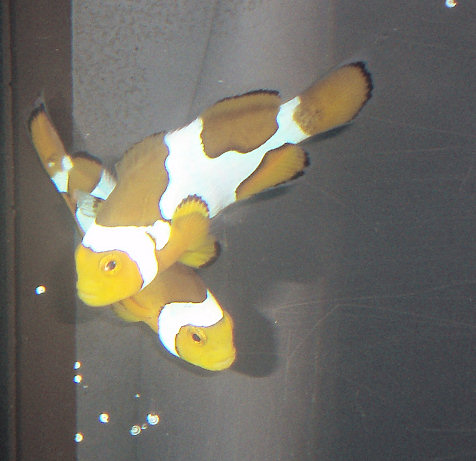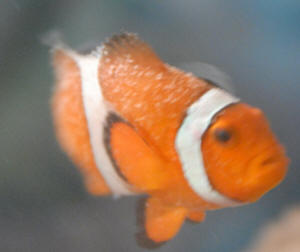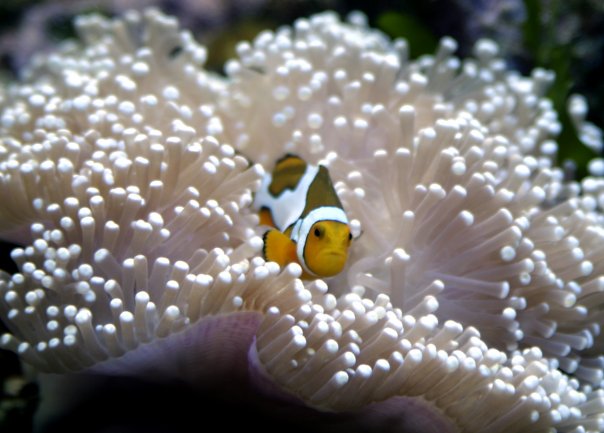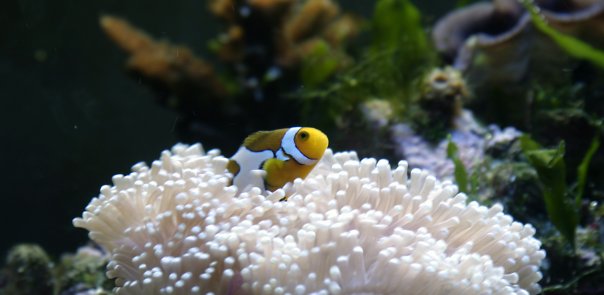|
|
Surviving Brooklynellosis
|
By Mike Maddox |

The author’s ‘Picasso breed’
Amphiprion percula in quarantine
I recently ordered a pair of ORA's 'Picasso' breed of percula clownfish
that arrived heavily infested with Brooklynellosis.
After a week in the quarantine tank and lots of medication, I was able
to fully cure my clownfish, with no losses! However, this
experience caused me to question “how often does the average hobbyist
see this disease? Will they be able to identify and treat it
quickly enough to prevent mortality?” I wanted to write a short
(and hopefully informative!) piece about Brooklynellosis. Because
Brooklynellosis can kill very fast, quick diagnosis and treatment is
essential.
The causes of Brooklynellosis
What is Brooklynellosis, you ask? Brooklynellosis is a protozoan
parasite that commonly affects wild caught clownfish, or captive bred
clownfish that were irresponsibly exposed to wild caught clownfish (as
was the case with my fish). Brooklynellosis symptoms include
excessive mucous production, white "fuzz" or "rashes" on the skin.
Infected fish will also show a rapid respiration rate and act listless.
Brooklynellosis symptoms include excessive mucous production and white
“fuzz” or “rashes” on the skin. Infected fish will also show an
increased respiration rate and tend to act listlessly.
Treatment
Once you've diagnosed Brooklynellosis, prompt treatment is essential.
Move the affected fish(es) to a quarantine tank, and begin treatment
with formalin. I used Quick Cure (a combination of formalin and
malachite green sold to treat ich and crypt, and available at almost
every pet store) at standard marine dose as directed. Because my
clownfish were also at a higher risk for secondary bacterial infection
due to their weakened immune system, I added Methylene blue and
erythromycin (also both sold at almost any pet store) to combat possible
bacterial infections. Finally, I dosed Seachem's StressGuard at a
double dose per day to help reduce stress and replace the fish’s slime
coat. My clownfish were lucky enough to make a full recovery after
5 days, and showed great improvement after only 24 hours.

A clownfish displaying
symptoms of Brooklynellosis
I also dosed the tank with StressGuard from Seachem at twice the normal
dose per day. I consider StressGuard to be an excellent product. My
clownfish showed great improvement after only 24 hours, and after five
days were fully recovered.
Great success has been had with the captive breeding of clownfish, so
Brooklynellosis isn't very common, and should never be seen in captive
bred fish. However, Brooklynellosis is much more prevalent in wild
caught fish or captive bred fish that have been kept with those from the
wild, so it's good to know what to look for. Once you know the
signs and symptoms, you will be able to identify and treat
Brooklynellosis rapidly, greatly increasing your fish’s chances of a
successful recovery.
 
|
Brooklynellosis on WWM
Related FAQs:
Brooklynellosis 1,
Brooklynellosis 2, & FAQs on Brooklynellosis:
Diagnosis/Symptomology,
Etiology/Prevention,
Cures That Don't Work,
Cures That Do Work,
Treatment/Products/Manufacturers... &
Clownfish Disease 1,
Clownfish Disease FAQs 3, Clownfish
Disease 4,
Clownfish Disease 5,
Clownfish Disease 10,
Clownfish Disease 12,
Clownfish Disease 13,
Clownfishes in
General,
Clownfish Identification,
Clownfish Selection,
Clownfish Compatibility,
Clownfish Behavior,
Clownfish Systems,
Clownfish Feeding,
Clownfishes and Anemones, Breeding
Clowns, Parasitic
Marine Tanks 1,
Marine Parasitic Disease,
Parasitic Reef Tanks,
Cryptocaryoniasis, Marine Ich,
Marine Velvet Disease,
Biological Cleaners,
Treating Parasitic
Disease,
Using Hyposalinity to
Treat Parasitic Disease,
Related Articles:
Clownfish Disease,
Brooklynellosis,
Clownfishes, Maroon
Clowns,
Marine Parasitic Disease,
|
|
|
|
|
|
